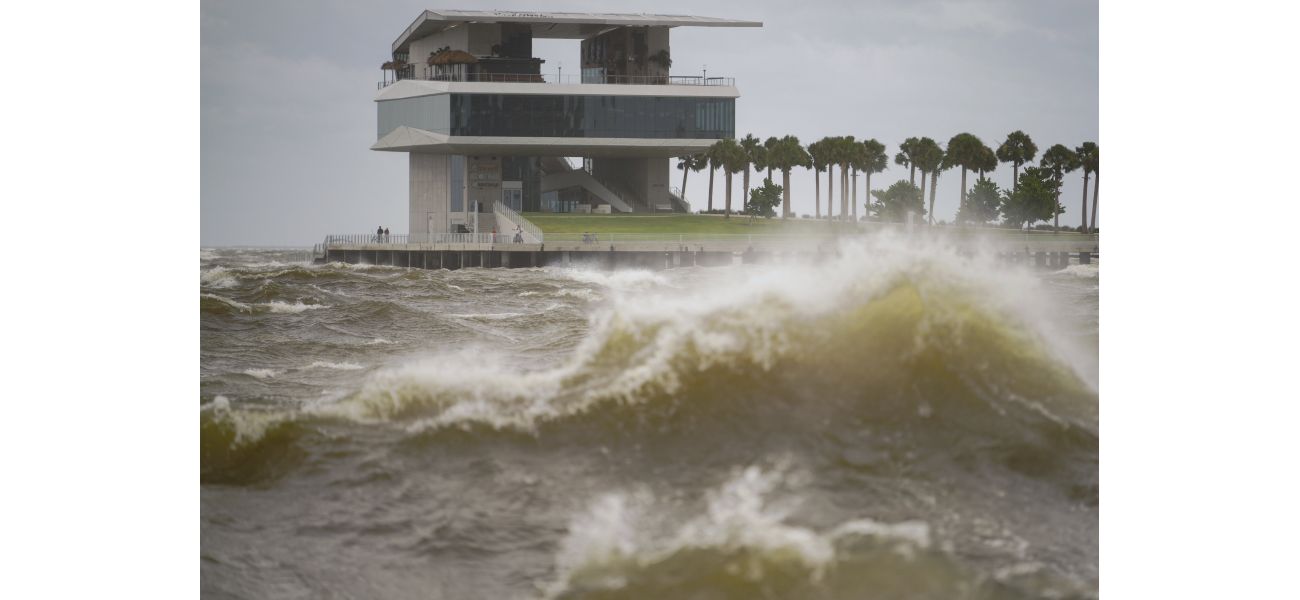Hurricane Helene hits Florida as a strong Category 4 storm.
Multiple states have declared emergencies due to strong winds causing power outages for over 250,000 properties.
September 27th 2024.

On Thursday evening, Hurricane Helene, a fast-moving Category 4 storm, hit Florida's northwestern coast in the Big Bend area. The storm brought with it a "catastrophic" storm surge, as well as damaging winds, heavy rains, and flash floods, which could affect areas hundreds of miles inland in the southeastern US. According to forecasters, the storm poses a significant threat to the region.
As the storm approached, authorities in Georgia reported two deaths, possibly due to a tornado, and Florida Governor Ron DeSantis announced that one person had died while driving on Interstate 4 when a sign fell onto their car. The storm also caused power outages, affecting over 1 million homes and businesses in Florida and over 50,000 in Georgia, according to poweroutage.us.
In response to the storm, states of emergency were declared in Florida, Georgia, the Carolinas, Virginia, and Alabama. Meanwhile, in the Pacific, former Hurricane John regained strength on Thursday morning, becoming a hurricane once again as it threatened the western coast of Mexico with flash flooding and mudslides. It was later downgraded to a tropical storm as it moved along the coast of Michoacan.
In the Atlantic Ocean, Tropical Storm Isaac formed on Wednesday and is expected to strengthen as it moves east, away from the US. Forecasters predict that it could become a hurricane by the end of the week.
Governor DeSantis expressed his concern for the safety of those in the storm's path, urging them to take precautions and stay safe. He also warned that there could be more fatalities as the storm progresses and that 3,500 National Guardsmen were ready to assist with the response efforts.
The hurricane made landfall in northwestern Florida near the city of Perry at around 11:10 p.m. EDT, with maximum sustained winds of 140 mph. The National Hurricane Center in Miami has issued warnings for "catastrophic" flooding along the Gulf Coast and storm surges of up to 20 feet, particularly in Apalachee Bay.
As of 11 p.m. EDT, over 885,000 customers in Florida were without power, with the majority of outages concentrated in the Big Bend area where Helene is expected to make landfall.
Meanwhile, the former Hurricane John, now a tropical storm, continues to move slowly along the coast of Michoacan, Mexico. The US National Hurricane Center has downgraded it from a hurricane and warns of severe flash flooding in coastal areas. John first hit Mexico on Monday as a Category 3 hurricane, causing significant damage and forcing it to weaken inland. However, it reemerged over the ocean and regained strength as a tropical storm before being downgraded again on Thursday.
The Hurricane Center predicts that John will continue to weaken on Thursday night and into Friday. The storm may bring some relief to the affected regions, but the threat of severe weather and its impact on people's lives and property remains a concern.
The powerful Hurricane Helene made its way towards the northwestern coast of Florida, bringing with it destructive winds and heavy rains. As a Category 4 storm, it was feared to cause catastrophic damage and a storm surge that could reach up to several feet. The entire southeastern region of the US was on high alert, with authorities issuing warnings and states declaring emergencies.
In Georgia, the storm had already claimed two lives as a possible tornado touched down in the southern part of the state. Florida Governor Ron DeSantis also confirmed the death of one person who was driving on Interstate 4 when a sign fell onto their car. The storm had already knocked out power to over a million homes and businesses in Florida, and over 50,000 in Georgia, according to poweroutage.us.
As the storm approached and made landfall, the entire region was bracing for the worst. States of emergency were declared in Florida, Georgia, the Carolinas, Virginia, and Alabama. The situation was dire, with forecasts predicting more fatalities and extensive property damage.
Meanwhile, the Pacific was also experiencing its own set of natural disasters. Former Hurricane John had re-strengthened into a hurricane, causing flash flooding and mudslides along Mexico's western coast. It was later downgraded to a tropical storm as it moved along the coast of the Mexican state of Michoacan.
In the Atlantic Ocean, Tropical Storm Isaac had formed and was expected to intensify into a hurricane as it moved away from the US. The storm was closely monitored by forecasters, who warned of its potential impact.
As the night progressed, the situation in Florida continued to worsen. Governor Ron DeSantis confirmed that one person had died while driving on Interstate 4, cautioning others to stay off the roads and seek shelter. He also announced that 3,500 National Guardsmen were ready to assist with any response efforts.
The National Hurricane Centre in Miami announced that Hurricane Helene had made landfall in northwestern Florida as a Category 4 storm, with maximum sustained winds of 140 mph. The storm had hit near Perry, Florida, in the Big Bend area, and was expected to bring catastrophic flooding along the Gulf Coast. Residents were urged to take all necessary precautions and heed evacuation orders.
The hurricane warnings extended beyond the coast, into northern Georgia and western North Carolina. Flash flood warnings were also in effect, as the storm continued to unleash its fury. As of 11 p.m. EDT, over 885,000 customers in Florida were without power, with several counties in the Big Bend area experiencing widespread outages.
In the Pacific, John had weakened to a tropical storm as it slowly moved along the coast of Mexico. However, it still posed a threat, with sustained winds of 70 mph and the potential for severe flash flooding. The storm had initially hit Mexico as a Category 3 hurricane, causing significant damage. After weakening and then reemerging over the ocean, it had regained strength and was now a tropical storm once again.
The hurricane centre predicted that John would continue to weaken as it moved further away from land. However, the impact of the storm was still being felt, and the situation was being closely monitored. With the potential for more hurricanes and natural disasters, it was a reminder for everyone to stay safe and prepared during these challenging times.
As the storm approached, authorities in Georgia reported two deaths, possibly due to a tornado, and Florida Governor Ron DeSantis announced that one person had died while driving on Interstate 4 when a sign fell onto their car. The storm also caused power outages, affecting over 1 million homes and businesses in Florida and over 50,000 in Georgia, according to poweroutage.us.
In response to the storm, states of emergency were declared in Florida, Georgia, the Carolinas, Virginia, and Alabama. Meanwhile, in the Pacific, former Hurricane John regained strength on Thursday morning, becoming a hurricane once again as it threatened the western coast of Mexico with flash flooding and mudslides. It was later downgraded to a tropical storm as it moved along the coast of Michoacan.
In the Atlantic Ocean, Tropical Storm Isaac formed on Wednesday and is expected to strengthen as it moves east, away from the US. Forecasters predict that it could become a hurricane by the end of the week.
Governor DeSantis expressed his concern for the safety of those in the storm's path, urging them to take precautions and stay safe. He also warned that there could be more fatalities as the storm progresses and that 3,500 National Guardsmen were ready to assist with the response efforts.
The hurricane made landfall in northwestern Florida near the city of Perry at around 11:10 p.m. EDT, with maximum sustained winds of 140 mph. The National Hurricane Center in Miami has issued warnings for "catastrophic" flooding along the Gulf Coast and storm surges of up to 20 feet, particularly in Apalachee Bay.
As of 11 p.m. EDT, over 885,000 customers in Florida were without power, with the majority of outages concentrated in the Big Bend area where Helene is expected to make landfall.
Meanwhile, the former Hurricane John, now a tropical storm, continues to move slowly along the coast of Michoacan, Mexico. The US National Hurricane Center has downgraded it from a hurricane and warns of severe flash flooding in coastal areas. John first hit Mexico on Monday as a Category 3 hurricane, causing significant damage and forcing it to weaken inland. However, it reemerged over the ocean and regained strength as a tropical storm before being downgraded again on Thursday.
The Hurricane Center predicts that John will continue to weaken on Thursday night and into Friday. The storm may bring some relief to the affected regions, but the threat of severe weather and its impact on people's lives and property remains a concern.
The powerful Hurricane Helene made its way towards the northwestern coast of Florida, bringing with it destructive winds and heavy rains. As a Category 4 storm, it was feared to cause catastrophic damage and a storm surge that could reach up to several feet. The entire southeastern region of the US was on high alert, with authorities issuing warnings and states declaring emergencies.
In Georgia, the storm had already claimed two lives as a possible tornado touched down in the southern part of the state. Florida Governor Ron DeSantis also confirmed the death of one person who was driving on Interstate 4 when a sign fell onto their car. The storm had already knocked out power to over a million homes and businesses in Florida, and over 50,000 in Georgia, according to poweroutage.us.
As the storm approached and made landfall, the entire region was bracing for the worst. States of emergency were declared in Florida, Georgia, the Carolinas, Virginia, and Alabama. The situation was dire, with forecasts predicting more fatalities and extensive property damage.
Meanwhile, the Pacific was also experiencing its own set of natural disasters. Former Hurricane John had re-strengthened into a hurricane, causing flash flooding and mudslides along Mexico's western coast. It was later downgraded to a tropical storm as it moved along the coast of the Mexican state of Michoacan.
In the Atlantic Ocean, Tropical Storm Isaac had formed and was expected to intensify into a hurricane as it moved away from the US. The storm was closely monitored by forecasters, who warned of its potential impact.
As the night progressed, the situation in Florida continued to worsen. Governor Ron DeSantis confirmed that one person had died while driving on Interstate 4, cautioning others to stay off the roads and seek shelter. He also announced that 3,500 National Guardsmen were ready to assist with any response efforts.
The National Hurricane Centre in Miami announced that Hurricane Helene had made landfall in northwestern Florida as a Category 4 storm, with maximum sustained winds of 140 mph. The storm had hit near Perry, Florida, in the Big Bend area, and was expected to bring catastrophic flooding along the Gulf Coast. Residents were urged to take all necessary precautions and heed evacuation orders.
The hurricane warnings extended beyond the coast, into northern Georgia and western North Carolina. Flash flood warnings were also in effect, as the storm continued to unleash its fury. As of 11 p.m. EDT, over 885,000 customers in Florida were without power, with several counties in the Big Bend area experiencing widespread outages.
In the Pacific, John had weakened to a tropical storm as it slowly moved along the coast of Mexico. However, it still posed a threat, with sustained winds of 70 mph and the potential for severe flash flooding. The storm had initially hit Mexico as a Category 3 hurricane, causing significant damage. After weakening and then reemerging over the ocean, it had regained strength and was now a tropical storm once again.
The hurricane centre predicted that John would continue to weaken as it moved further away from land. However, the impact of the storm was still being felt, and the situation was being closely monitored. With the potential for more hurricanes and natural disasters, it was a reminder for everyone to stay safe and prepared during these challenging times.
[This article has been trending online recently and has been generated with AI. Your feed is customized.]
[Generative AI is experimental.]
0
0
Submit Comment





